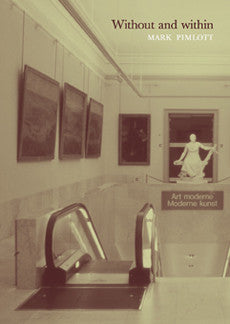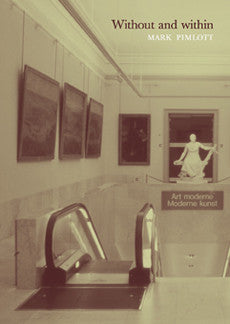Your cart is currently empty!
Theory
Without and Within: Essays on Territory and the Interior
+++ +++
+++Mark Pimlott+++
978-90-5973-034-2 [episode]
Joost Grootens
336
24 x 17
Swiss binding
Only available in English.
Awarded 'Best Dutch Book Design 2007'
This publication has been made possible with support of the Netherlands Architecture Fund
The richly illustrated book Without and within: essays on territory and the interior contains a series of essays that trace a thread of ideas, images and projections that connect the American territory as conceived by Thomas Jefferson to the contemporary continuous interior environment ubiquitous in public experience. It is a story of ideas contained therein, their implementation and their consequences.
In the United States in the nineteenth century, the territorialisation of the American West–– enormous, conceptually empty, potentially redemptive––established an 'American space' that in the twenty-first century remains the scene that situates, defines and relates the full array of infrastructures, buildings and interiors that are the settings for public and private life. Developments of the new American city articulated implicit aspects of Jefferson's ideology and its instruments, and nurtured the mythology of American nature.

The American city also borrowed and adapted innovations from the industrialised European metropolis, whose proposed relations between technology, display, spectacle and the public all had an enormous impact on its fiercely individualistic and competitive counterpart. The characteristics of the American city of the post-war period––dispersed over huge regions, figured with motorway networks, automobiles, tract houses, shopping malls, regional corporate offices, derelict downtowns and their corresponding interiorised networks and spectacles––can all be seen as part of an ideological and historical continuum. All of its constituents are interdependent, deeply embedded in the American consciousness.

The most common type of contemporary large-scale space––with which almost everyone who has walked through a shopping mall, an international airport or the entrance area of a major museum is familiar––embodies aspects of the corporate lobby, the winter garden, the shopping mall and the transport terminal concourse. In such spaces, representations of complex ideas exchanged between America and Europe––including ideas of social and capitalist utopias alike––have been incorporated and mastered. With such mastery, these environments assert their hegemony, and so find applicability everywhere. The self-sufficiency of such environments habitually negates the existence of a World without, which is reduced to that domain from which people who will submit to the interior are captured. As a consequence of American cultural and economic hegemony, such spaces are becoming representative of interiors experienced by the mass in Europe and beyond, who occupy them under the impression that they are not a mass, but a public.
Mark Pimlott (Montréal, 1958) is an artist, designer and writer. He works in The Hague and London. He studied architecture at McGill University, Montréal and the Architectural Association, London; and visual arts at Goldsmiths College, University of London. His work––writing, architectural design, photography, film, public art––attempts to make the specific characteristics of places visible and so render them available to the imagination. Public art commissions include Guinguette, Birmingham, 2000; La scala, Aberystwyth, 2003; La nuit, London, 2009; and World, at BBC Broadcasting House, London, which will be completed towards the end of 2010. Among his films are 1965, 1997; One and The other, 1999; and Ich bin der Welt abhanden gekommen, 2005. Among his interior designs are those for Neckinger Mills, London, 1988; the Red House, London, 2001; 2004; 2009; and restaurant Puck & Pip, The Hague, 2007.

€37.50
Without and Within: Essays on Territory and the Interior
€37.50
Architecture / Awarded / Theory / Urbanism
978-90-5973-034-2 [episode]
Joost Grootens
336
24 x 17
Swiss binding
Only available in English.
Awarded 'Best Dutch Book Design 2007'
This publication has been made possible with support of the Netherlands Architecture Fund
The richly illustrated book Without and within: essays on territory and the interior contains a series of essays that trace a thread of ideas, images and projections that connect the American territory as conceived by Thomas Jefferson to the contemporary continuous interior environment ubiquitous in public experience. It is a story of ideas contained therein, their implementation and their consequences.
In the United States in the nineteenth century, the territorialisation of the American West–– enormous, conceptually empty, potentially redemptive––established an 'American space' that in the twenty-first century remains the scene that situates, defines and relates the full array of infrastructures, buildings and interiors that are the settings for public and private life. Developments of the new American city articulated implicit aspects of Jefferson's ideology and its instruments, and nurtured the mythology of American nature.

The American city also borrowed and adapted innovations from the industrialised European metropolis, whose proposed relations between technology, display, spectacle and the public all had an enormous impact on its fiercely individualistic and competitive counterpart. The characteristics of the American city of the post-war period––dispersed over huge regions, figured with motorway networks, automobiles, tract houses, shopping malls, regional corporate offices, derelict downtowns and their corresponding interiorised networks and spectacles––can all be seen as part of an ideological and historical continuum. All of its constituents are interdependent, deeply embedded in the American consciousness.

The most common type of contemporary large-scale space––with which almost everyone who has walked through a shopping mall, an international airport or the entrance area of a major museum is familiar––embodies aspects of the corporate lobby, the winter garden, the shopping mall and the transport terminal concourse. In such spaces, representations of complex ideas exchanged between America and Europe––including ideas of social and capitalist utopias alike––have been incorporated and mastered. With such mastery, these environments assert their hegemony, and so find applicability everywhere. The self-sufficiency of such environments habitually negates the existence of a World without, which is reduced to that domain from which people who will submit to the interior are captured. As a consequence of American cultural and economic hegemony, such spaces are becoming representative of interiors experienced by the mass in Europe and beyond, who occupy them under the impression that they are not a mass, but a public.
Mark Pimlott (Montréal, 1958) is an artist, designer and writer. He works in The Hague and London. He studied architecture at McGill University, Montréal and the Architectural Association, London; and visual arts at Goldsmiths College, University of London. His work––writing, architectural design, photography, film, public art––attempts to make the specific characteristics of places visible and so render them available to the imagination. Public art commissions include Guinguette, Birmingham, 2000; La scala, Aberystwyth, 2003; La nuit, London, 2009; and World, at BBC Broadcasting House, London, which will be completed towards the end of 2010. Among his films are 1965, 1997; One and The other, 1999; and Ich bin der Welt abhanden gekommen, 2005. Among his interior designs are those for Neckinger Mills, London, 1988; the Red House, London, 2001; 2004; 2009; and restaurant Puck & Pip, The Hague, 2007.












